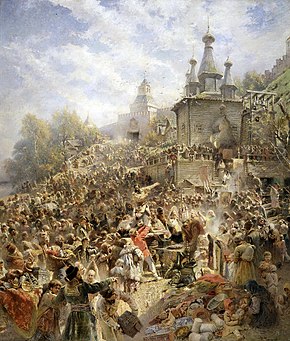Our website is made possible by displaying online advertisements to our visitors.
Please consider supporting us by disabling your ad blocker.
Time of Troubles

The Time of Troubles (Russian: Смутное время, romanized: Smutnoye vremya), also known as Smuta (Russian: Смута, lit. 'troubles'),[1] was a period of political crisis in Russia which began in 1598 with the death of Feodor I,[2] the last of the House of Rurik, and ended in 1613 with the accession of Michael I of the House of Romanov.
It was a period of deep social crisis and lawlessness following the death of Feodor I, a weak and possibly intellectually disabled ruler who died without an heir. His death ended the Rurik dynasty, leading to a violent succession crisis with numerous usurpers and false Dmitrys (imposters) claiming the title of tsar.[3] Russia experienced the famine of 1601–1603, which killed almost a third of the population, within three years of Feodor's death. Russia was also occupied by the Polish–Lithuanian Commonwealth during the Polish–Russian War and lost Smolensk.
The Time of Troubles ended with the election of Michael Romanov as tsar by the Zemsky Sobor in 1613, establishing the Romanov dynasty, which ruled Russia until the February Revolution in 1917.
- ^ Gruber, Isaiah (2012). Orthodox Russia in Crisis: Church and Nation in the Time of Troubles. Cornell University Press. p. 9. ISBN 978-1-5017-5738-9.
- ^ "Britannica – Fyodor I". Encyclopedia Britannica. Archived from the original on 2022-10-11. Retrieved 2020-04-24.
- ^ Ehlers, Kai. (2009). Russland – Herzschlag einer Weltmacht. Pforte-Verlag. ISBN 978-3-85636-213-3. OCLC 428224102.
Previous Page Next Page


